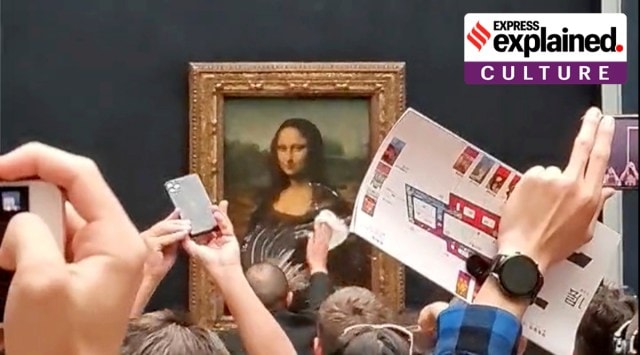- India
- International
Explained: Mona Lisa — widely loved, frequently attacked
Considered an archetypal masterpiece of the Italian Renaissance, Leonardo da Vinci's Mona Lisa is believed to have been painted between 1503 and 1517.
 A security guard cleans the smeared cream from the glass protecting the Mona Lisa at the Louvre Museum, in Paris, France, Sunday, May 29, 2022. (Via AP)
A security guard cleans the smeared cream from the glass protecting the Mona Lisa at the Louvre Museum, in Paris, France, Sunday, May 29, 2022. (Via AP)Arguably the most recognised painting in the world, Leonardo da Vinci’s Mona Lisa, housed at the Louvre museum in Paris, was smeared with cake by a climate activist disguised as an elderly woman on Sunday. There was no damage to the Renaissance artwork, which is protected by a bulletproof glass.
The painting
Considered an archetypal masterpiece of the Italian Renaissance, it is believed to have been painted between 1503 and 1517.
Dressed in Florentine fashion, the half-length portrait has a figure seated against a mountainous landscape painted in sfumato technique, where there is a play of light and shade and the colours are blended into each other with no evident boundaries.
While one proposition offered is that both a man and a woman modelled for the portrait, another set believes it is a disguised self-portrait of its Italian polymath creator.
However, the subject of the painting is largely believed to be Lisa Gherardini, wife of Francesco del Giocondo, a wealthy silk merchant from Florence. Historians believe Francesco commissioned the painting for their new home and to celebrate the birth of their second son, Andrea.

It has been a subject of numerous studies. While some admire the work for the manner in which da Vinci applied his study of human anatomy during its conception, Mona Lisa’s enigmatic expression, which seems both enticing and distant, has intrigued viewers for centuries.
The masterpiece that has several copies across the world, also has a twin. Discovered in 2012, the much brighter version at the Museo del Prado in Madrid is believed to have been painted by one of da Vinci’s main assistants, Melzi or Salai, at the same time as the master. Using infrared technology, conservators reportedly discovered that Leonardo and the painter of the replica made exactly the same changes to their works at the same time.
Owners
Though da Vinci began working on the portrait when he was based in Florence, he continued to add details to it for years, taking it with him to France in 1517, when he travelled there on the invitation of King Francis I. On his death in Amboise, France, da Vinci’s assistant Salai, who reportedly inherited the work, sold the painting to King Francis I of France. It was kept at the Palace of Fontainebleau, until Louis XIV moved it to the Palace of Versailles.
Following the French Revolution, it was reportedly also hung in Napoleon Bonaparte’s bedroom at Tuileries Palace for a while.
Owned by the French Republic, the work that was always acclaimed in the art circle, catapulted to public fame when it was stolen from the Louvre museum in 1911. It was the work of Italian handyman Vincenzo Peruggia, who had been hired to design a glass case for the work. After a successful theft, he managed to keep it hidden in his apartment for two years, and was only caught when he tried to contact an Italian dealer, who alerted Giovanni Poggi, the then director of the Uffizi Gallery in Florence.
Past attacks
The Mona Lisa has been attacked multiple times in the past.
In 1956, a vandal threw acid on the painting causing some damage to it while it was on display in Montauban, France. That same year in December, a South American tourist hurled a rock at it at the Louvre museum causing the glass to shatter, and the paint to chip a little. The painting was subsequently restored.
Newsletter | Click to get the day’s best explainers in your inbox
In 1974, when the work was on display at the Tokyo National Museum, a differently-abled woman sprayed red paint over its glass case to show her dissatisfaction regarding lack of access for the disabled at the museum.
Denied French citizenship, a Russian woman hurled a coffee mug at the painting in August 2009, but fortunately it caused no damage to the work.
More Explained
EXPRESS OPINION
Jun 01: Latest News
- 01
- 02
- 03
- 04
- 05








































